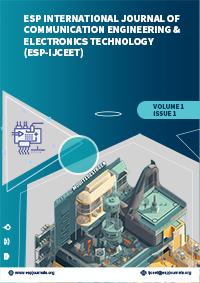ESP International Journal of Communication Engineering & Electronics Technology (ESP-IJCEET)
Citation :
G. Prammasakthi Priya, A. SamsuNighar, 2023. "Efficient Majority Voting in Digital Hardware using Geffe Generator" ESP International Journal of Communication Engineering & Electronics Technology (ESP- IJCEET) Volume 1, Issue 3 : 1-6
.Abstract :
Linear-feedback Shift Registers (LFSRs) are pivotal components in digital circuitry, characterized by their ability to generate sequences based on a linear function of their previous states. This paper delves into the fundamental principles, applications, and advancements in LFSR technology.
LFSRs find extensive use in creating pseudo-random sequences, which are crucial in various domains such as cryptography, communication, and probabilistic algorithms. Understanding the mathematical basis of LFSRs, their feedback polynomials, and tap configurations is essential for designing effective pseudo-random sequence generators. In the context of Built-In Self-Test (BIST) for digital circuits, LFSRs are key to optimizing test pattern generation. Innovations in segmentation techniques and the integration of LFSRs into BIST architectures enhance the efficiency and accuracy of testing procedures. Moreover, this paper explores the role of LFSRs in data compression. By investigating techniques such as Huffman coding and complementary coding, we demonstrate how LFSRs contribute to efficient compression schemes, reducing hardware overhead while maintaining data integrity.
Overall, this research sheds light on the multifaceted applications of LFSRs, from generating pseudo-random sequences to improving digital circuit testing and data compression. By harnessing the power of LFSRs, we advance technology in diverse fields.
References :
[1] M. Abramovici, M. A. Breuer, and A. D. Friedman, Digital System Testing and Testable Design, IEEE CS Press, New York, 1990.
[2] F. Berglez, D. Bryan, and K. Kozminski, Combinational Profiles of Sequential Benchmark Circuits, Proc. IEEE Int. Symposium on Circuits and System, pp. 1929-1934, 1989.
[3] D. Densmore, “Built-In-Self Test (BIST) implementations an overview of design tradeoffs”, Technical paper, University of Michigan, 2001. [Online]Available: http://www.cs.berkeley.edu/~densmore/documents/BIST.pdfI.
[4] P. R. Geffe, “How to protect data with ciphers that are really hard to break”, Electronics, Vol 46, pp. 99-101, 1973.
[5] P. Girard, “Survey of low-power testing of VLSI circuits”, IEEE Design & Test of Computers, Vol 19, pp. 80 – 90, May-June 2002.
[6] G. Marven, Entropy Based Evaluation of Binary Sequences Produced by ALFSRs, M. Sc. Thesis, Department of Computer Science, University of Victoria, 1994.
[7] M. Puczko and V.N Yarmolik, “Designing cryptographic key generators with low power consumption”, Electronic Design, Test and Applications, 2006. DELTA 2006. Third IEEE International Workshop , pp. 418 – 421, January 2006.
[8] J. Zhong and J. C. Muzio, “A comparison of generators for testing sequential circuits using BIST”, IEEE International Workshop on Logic & Synthesis, pp. 231-235, May 2003.
[9] Livinka S, Divya Dharshini R, 2023. "Smart Traffic Management System Using IoT" ESP Journal of Engineering & Technology Advancements 3(2): 1-7.
[10] J. Zhong and J. C. Muzio, “An investigation of non-linear machines as PRPGs in BIST”, International Conference on VLSI, June 2004.
[11] Bala Murugan P, Kaliammal N, Selvi C, 2022. "Qca Design of Approximate Adder" ESP Journal of Engineering & Technology Advancements 2(3): 5-8.
[12] K. Zeng, C. Yang, D. Wei and T. R. R. Rao, “Pseudoramdom bit generators in stream-cipher cryptography”, IEEE Computer Society, Vol 24, pp. 8-17, February 1991.
Keywords :
Digital Hardware, Geffe, Generator, BIST, LFSR.


